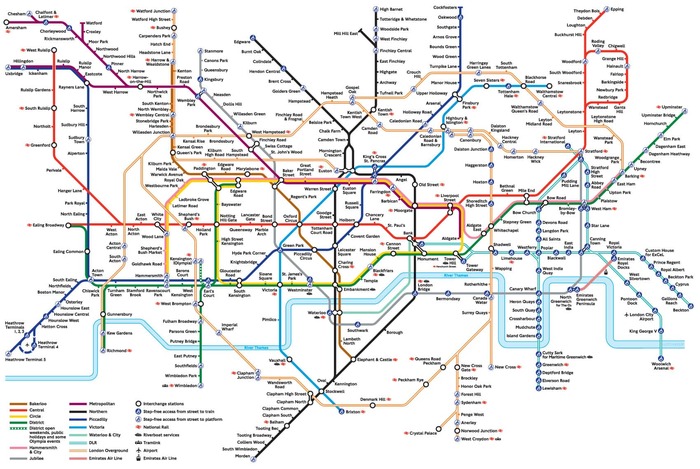
How to get around by metro?
The London Underground (tube or underground) has 11 lines - it is one of the most extensive transport networks in the world.
It is the most convenient and fastest public transport to get around London!
Zones
London is divided into 9 zones - which have their origin in the historic city center.
advertisement
The London transport card is divided into 6 fare zones concentric: zones 1 and 2 correspond to central London and zones 6 to 9 cover the outskirts of the capital.
Prices
Is public transport free for children?
Oyster card and Travelcard
You can check the prices for the metro and train journeys - Pay as you go and Travelcards - on the official London transport website (TfL).
The price of a journey in Pay as you go by metro is calculated according to the zones crossings and the travel period:
- The Peak period corresponds to peak hours and is therefore more expensive - it applies Monday to Friday from 6:30am to 9:30am and from 4pm to 7pm.
- The Off-peak period corresponds to off-peak hours and is therefore cheaper - it applies on weekends and outside of peak hours the week.
During the week, all trips to zone 1 and from another zone - made between 4pm and 7pm - are considered Off-peak.
The tool Caps and Travelcard prices allows you to compare the price limits of the Pay as you go and the Travelcard for your regular trips.
You can know the exact cost of a trip depending on the areas crossed and the traveler profile with Single fare finder search tool on the official London Transport website (TfL).
Tickets
To buy a metro ticket you need to know the areas where your departure and arrival stops are located:
- Zones 1-3: £4.90
- Zones 1-5: £5.90
- Zones 1-6: £6
For example, the "Zones 1-3" ticket allows you to take the metro from zone 3 to go to zone 1.
In order to benefit from the best rates and avoid the queues, it is advisable to opt for a Oyster card and/or Travelcard.
The best tourist attractions are mostly located in zones 1 and 2.
Times and frequency of passage
Opening hours
Most London Underground stations are open 5am to 12am - the departure time of the last train.
Since August 19, 2016, the 5 metro lines Victoria (light blue), Central (red), Jubilee (gray), Northern (black) and Piccadilly (dark blue) - as well as the London Overground (orange) - operate 24 hours a day on Fridays and Saturdays (night tube).
Passage frequency
The frequency of use varies depending on the line and the schedule.
In zones 1 and 2, the waiting time does not generally exceed 5 minutes.
The number of trains in circulation is restricted on Sundays.
Metro map
You can consult the London Underground map on the official London transport website (TfL).
Paper cards are also available for self-service in all underground stations and London Travel Information centres.
Designed in 1933 by Harry Beck, the London Underground map is very practical - it clearly indicates the direction of the trains (north, south, east and west) and the various connections between the lines.

Accessibility
Most of the platforms in London Underground stations are accessible only by stairs.
Deep metro line platforms are usually accessible by escalators or elevators - but almost all of these stations have stairs that connect the station to the street and/or escalators or elevators to the platforms.
Some stations have a step or an interval of 20 cm between the platform and the train.
Accessible metro stations
The official London transport underground map (above) tells you which tube stations are step-free from street to platform or street to train.
It is advisable to get on the first car so that the driver can see you and give you time to get on and off the metro.
DLR and London Overground
The DLR (Docklands Light Railway) - an interconnected commuter train network - and the London Overground are 2 additional lines which are fully integrated into the London Underground.
The DLR (Docklands Light Railway) takes you to Greenwich.